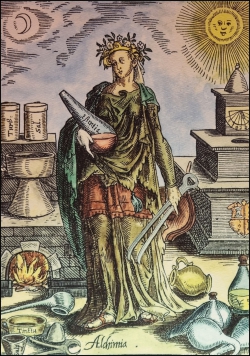The Middle Ages: between alchemy and science
Medieval Age (476 AD - 1492)
Arab alchemists, including Rhazes (860-940) and Avicenna (980-1037), described the preparation of the "water of life" and the distillation method that enriches the product by passing alcoholic vapors through ashes or quicklime; they also distilled mercury and perhaps alcohol, without knowing it. Originally, the word "alcohol," from the Arabic "al-kohol," meant the "fine powder," a black impalpable powder used by women as eye makeup. The Arab alchemist Abu Musa Jabir ibn Hayyan al-Azdi, known as Geber (721-815), described the apparatus used for the distillation of plants, including rose water, whose essential oil was indicated as a remedy for many diseases. Arabic science had the great merit of passing on knowledge of distillation to medieval European science.
The Salerno School played a significant role, collecting and deepening the study and research of these knowledge from the 10th century onwards. Later, alchemy spread more and was also practiced in monasteries. In these centers of learning, we find scholars like Albertus Magnus (1193-1280), who in some of his writings spoke of a fiery water obtained from wine, so light that it floated on olive oil.
The Salerno School played a significant role, collecting and deepening the study and research of these knowledge from the 10th century onwards. Later, alchemy spread more and was also practiced in monasteries. In these centers of learning, we find scholars like Albertus Magnus (1193-1280), who in some of his writings spoke of a fiery water obtained from wine, so light that it floated on olive oil.
The First Innovations
Taddeo Alderotti of Florence (1215-1302), in the Vatican codex Consilia of 1276, described in detail the production of aquavitae obtained from wine through double distillations. Alderotti is also the first to mention the serpentine immersed in cold water for the condensation of vapors. Between the 13th and 14th centuries, the water cooling system appeared. The spout of the capital, instead of ending directly in the vessel collecting the distillate, was passed through a small barrel filled with cold water; this would be discussed by the Sienese Andrea Mattioli (1570 - 1577), an important scholar and philologist, a few centuries later.
Venice, the pearl of the Adriatic, played a significant role in the commercialization of spirits. Distillation spread in the Veneto region between the 12th and 13th centuries, when Venice was an important market for wine aquavitae and grape marc, which were exported to Germany and the East, as remedies for the plague and gout.
By the end of the 13th century, the preparation of wine aquavitae became popular, when the Paduan physician Michele Savonarola (1385-1468) published the first treatise on its preparation, the "De Conficienda Aqua Vitae," considered a fundamental document in the history of distillation, as it promoted the practice, knowledge, and use of aqua vitae.
One legendary alchemist is considered to be the link between medieval alchemy and Renaissance medical chemistry: Theopharst Bombast von Hohenheim, also called Paracelso (1493-1541). He was the first to use the term alcohol, with the meaning of excellent refinement, as a synonym for wine spirit or aqua ardens.
Venice, the pearl of the Adriatic, played a significant role in the commercialization of spirits. Distillation spread in the Veneto region between the 12th and 13th centuries, when Venice was an important market for wine aquavitae and grape marc, which were exported to Germany and the East, as remedies for the plague and gout.
By the end of the 13th century, the preparation of wine aquavitae became popular, when the Paduan physician Michele Savonarola (1385-1468) published the first treatise on its preparation, the "De Conficienda Aqua Vitae," considered a fundamental document in the history of distillation, as it promoted the practice, knowledge, and use of aqua vitae.
One legendary alchemist is considered to be the link between medieval alchemy and Renaissance medical chemistry: Theopharst Bombast von Hohenheim, also called Paracelso (1493-1541). He was the first to use the term alcohol, with the meaning of excellent refinement, as a synonym for wine spirit or aqua ardens.



